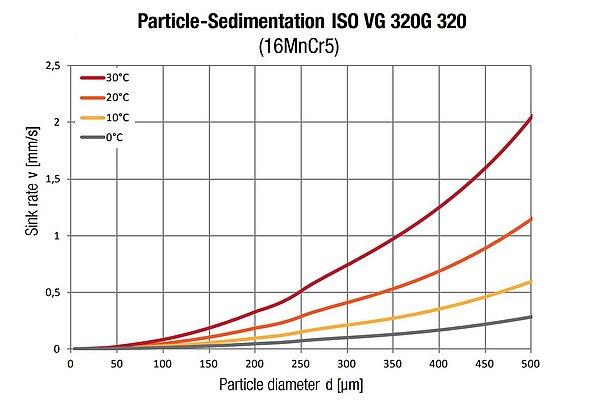The time factor when taking samples correctly
Can the validity of an oil sample change because the wear particles suspended in the oil deposit too quickly? One of our industrial gearboxes is regularly monitored using your lubricant analyses. The last analysis suddenly showed an exceptionally low PQ value. All other values were on trend. A control sample taken a few days later showed the expected PQ index. As always, we did not take the anomalous sample from or just in front of the oil sump after a long weekend. However, the gearbox was not in operation, otherwise we have always taken the sample during operation. Could this have influenced the result?

OELCHECK answers:
The time when the sample was taken can affect certain values. It is not without reason that we advise as follows in our sampling guidelines: „During operation or just after standstill as dirt and wear particles are suspended.“ If, however, you take oil, for example, in the morning from a machine that was not in operation over the weekend or hours after a wind power station was stopped operating, the sample may not contain all information. However, the time factor not only plays an important role when taking samples. It also has a significant role in our laboratory. In order to be able to optimally carry out the visual check, the sample containers must rest upside-down for approximately 15 minutes at 40°C. This allows the wear particles from the highly viscous oils to settle on the white cover seal.
The sealed sample containers are also placed upside down on the particle quantifier to determine the PQ index‘. It detects magnetisable iron wear particles in the sample using its magnetic coils. While the value given in the lab report for „iron“ in mg/kg only relates to particles smaller than 5 µm, the PQ index provides information on all magnetisable iron particles regardless of particle size.
In order to obtain a representative sample, they should always be taken as close as to when the machine is in operation as possible. However, some values can only be determined after a rest time. The velocity at which particles in the oil move and deposit through gravitation depends on:
- the size of the particle and its density (its weight, too)
- the oil viscosity, which is also temperature dependent.
The velocity at which a spherical particle sinks or sediments in a liquid can be calculated using „Stoke‘s Law“. For non-spherical bodies half of its equivalent diameter is used rather than the particle radius. We have used this „Stoke‘s Law“ to obtain comparable values for the sinking velocities of metal particles in a lubricating oil.
During these calculations we assumed that the metal particles are almost spherical in shape. A magnetisable chrome steel, which is typically used for gear teeth in gearboxes, was taken as the material for the particles. At approx. 8 kg/dm³, it is almost nine times as dense as the oil which is approx. 0.9 kg/dm³. The sinking velocity of particles with a diameter of 5 µm (> 4 µm smallest particle size during particle count in accordance with ISO 4406), 50 µm (just visible with the naked eye) and 500 µm (particle from a damaged aggregate) was calculated. A conventional CLP 320 gearbox oil was taken as the lubricant. Depositing was calculated for temperatures of 0°C, 20°C and 60°C, as can occur when taking typical samples.
| Sedimentation speeds and duration | ||
|---|---|---|
Steel particle size | Sedimentation speed | Sedimentation duration |
at 0 °C in oil ISO VG 320 | ||
5 µm | 0.000018 mm/s | 322 days |
50 µm | 0.003 mm/s | 2 days |
500 µm | 0.282 mm/s | 30 minutes |
at 20 °C in oil ISO VG 320 | ||
5 µm | 0.000073 mm/s | 79 days |
50 µm | 0.011 mm/s | 12.5 hours |
500 µm | 1.14 mm/s | 7 minutes |
at 60 °C in oil ISO VG 320 | ||
5 µm | 0.00052 mm/s | 11 days |
50 µm | 0.082 mm/s | 1.5 hours |
500 µm | 8.16 mm/s | 1 minutes |
Conclusion
- 5 µm particles never completely settle. Even after an aggregate has stopped, they remain in full concentration in an oil sample, regardless of how long after downtime and where the oil was taken.
- 50 µm particles, which are visible to the naked eye and are counted at > 14 µm during particle counting, can fall over a distance of 0.5 m over a weekend. In this case at least a short start should take place before the sample is taken or the sample should be taken from further down.
- 500 µm particles, which indicate acute damage, can sink into the oil sump in a few minutes. Depending on where the sample was taken, if the sample was only taken after a long downtime, the sample contains either too many or none at all. Such large particles, which would block the particle counter with the measuring cell cross-section of 100 µm, should not be considered in the particle count.
In our laboratory the time span of 20 minutes in which the oil samples stand upside down is completely sufficient for detecting all the magnetisable particles. In return, samples should always be taken during operation or as quickly as possible after the machine stops moving. A sample can only be representative if this is done, which is necessary for or lab reports to be valid.
An accurate and quick sample is therefore completely in your best interest!
Also read: How do I take an oil sample correctly?
OELCHECKER Winter 2014, page 8



